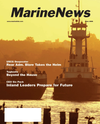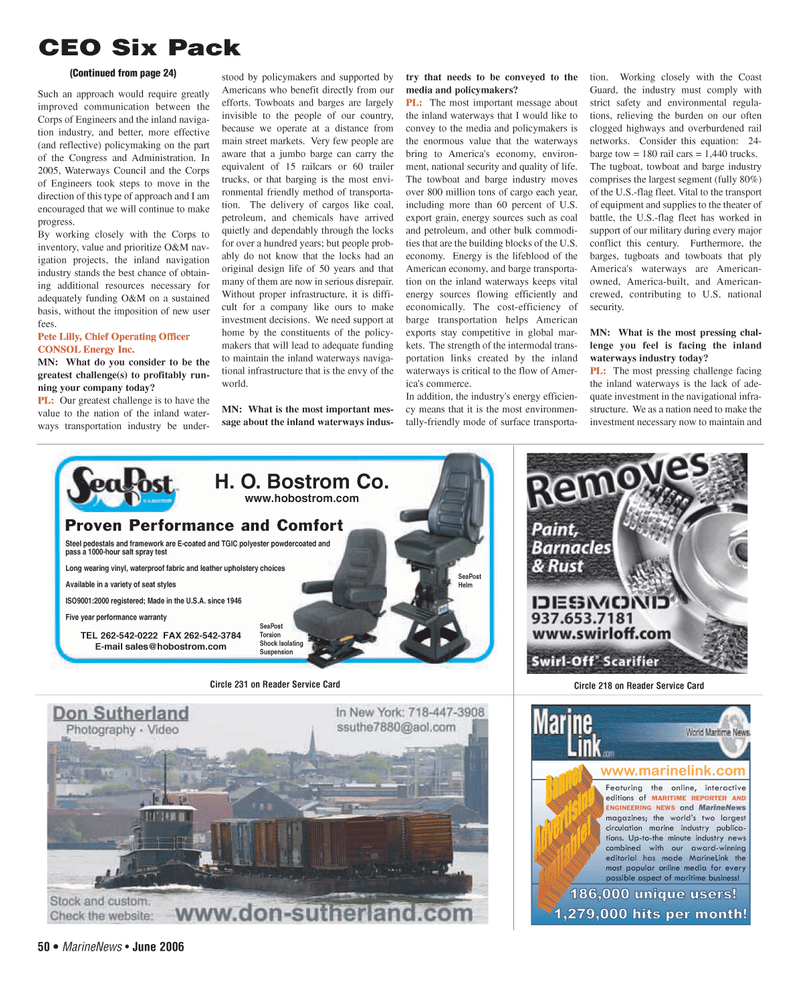
Page 50: of Marine News Magazine (June 2006)
Fourth Annual "Geo Six Pack"
Read this page in Pdf, Flash or Html5 edition of June 2006 Marine News Magazine
Such an approach would require greatly improved communication between the
Corps of Engineers and the inland naviga- tion industry, and better, more effective (and reflective) policymaking on the part of the Congress and Administration. In 2005, Waterways Council and the Corps of Engineers took steps to move in the direction of this type of approach and I am encouraged that we will continue to make progress.
By working closely with the Corps to inventory, value and prioritize O&M nav- igation projects, the inland navigation industry stands the best chance of obtain- ing additional resources necessary for adequately funding O&M on a sustained basis, without the imposition of new user fees.
Pete Lilly, Chief Operating Officer
CONSOL Energy Inc.
MN: What do you consider to be the greatest challenge(s) to profitably run- ning your company today?
PL: Our greatest challenge is to have the value to the nation of the inland water- ways transportation industry be under- stood by policymakers and supported by
Americans who benefit directly from our efforts. Towboats and barges are largely invisible to the people of our country, because we operate at a distance from main street markets. Very few people are aware that a jumbo barge can carry the equivalent of 15 railcars or 60 trailer trucks, or that barging is the most envi- ronmental friendly method of transporta- tion. The delivery of cargos like coal, petroleum, and chemicals have arrived quietly and dependably through the locks for over a hundred years; but people prob- ably do not know that the locks had an original design life of 50 years and that many of them are now in serious disrepair.
Without proper infrastructure, it is diffi- cult for a company like ours to make investment decisions. We need support at home by the constituents of the policy- makers that will lead to adequate funding to maintain the inland waterways naviga- tional infrastructure that is the envy of the world.
MN: What is the most important mes- sage about the inland waterways indus- try that needs to be conveyed to the media and policymakers?
PL: The most important message about the inland waterways that I would like to convey to the media and policymakers is the enormous value that the waterways bring to America's economy, environ- ment, national security and quality of life.
The towboat and barge industry moves over 800 million tons of cargo each year, including more than 60 percent of U.S. export grain, energy sources such as coal and petroleum, and other bulk commodi- ties that are the building blocks of the U.S. economy. Energy is the lifeblood of the
American economy, and barge transporta- tion on the inland waterways keeps vital energy sources flowing efficiently and economically. The cost-efficiency of barge transportation helps American exports stay competitive in global mar- kets. The strength of the intermodal trans- portation links created by the inland waterways is critical to the flow of Amer- ica's commerce.
In addition, the industry's energy efficien- cy means that it is the most environmen- tally-friendly mode of surface transporta- tion. Working closely with the Coast
Guard, the industry must comply with strict safety and environmental regula- tions, relieving the burden on our often clogged highways and overburdened rail networks. Consider this equation: 24- barge tow = 180 rail cars = 1,440 trucks.
The tugboat, towboat and barge industry comprises the largest segment (fully 80%) of the U.S.-flag fleet. Vital to the transport of equipment and supplies to the theater of battle, the U.S.-flag fleet has worked in support of our military during every major conflict this century. Furthermore, the barges, tugboats and towboats that ply
America's waterways are American- owned, America-built, and American- crewed, contributing to U.S. national security.
MN: What is the most pressing chal- lenge you feel is facing the inland waterways industry today?
PL: The most pressing challenge facing the inland waterways is the lack of ade- quate investment in the navigational infra- structure. We as a nation need to make the investment necessary now to maintain and 50 • MarineNews • June 2006
SeaPost
Torsion
Shock Isolating
Suspension
SeaPost
Helm
TEL 262-542-0222 FAX 262-542-3784
E-mail [email protected]
Proven Performance and Comfort
Steel pedestals and framework are E-coated and TGIC polyester powdercoated and pass a 1000-hour salt spray test
Long wearing vinyl, waterproof fabric and leather upholstery choices
Available in a variety of seat styles
ISO9001:2000 registered; Made in the U.S.A. since 1946
Five year performance warranty
H. O. Bostrom Co. www.hobostrom.com
Circle 231 on Reader Service Card
Featuring the online, interactive editions of MARITIME REPORTER AND
ENGINEERING NEWS and MarineNews magazines; the world’s two largest circulation marine industry publica- tions. Up-to-the minute industry news combined with our award-winning editorial has made MarineLink the most popular online media for every possible aspect of maritime business! www.marinelink.com
Circle 218 on Reader Service Card
CEO Six Pack (Continued from page 24)
JUNE MN2006 7(49-56).qxd 6/2/2006 4:27 PM Page 50

 49
49

 51
51
